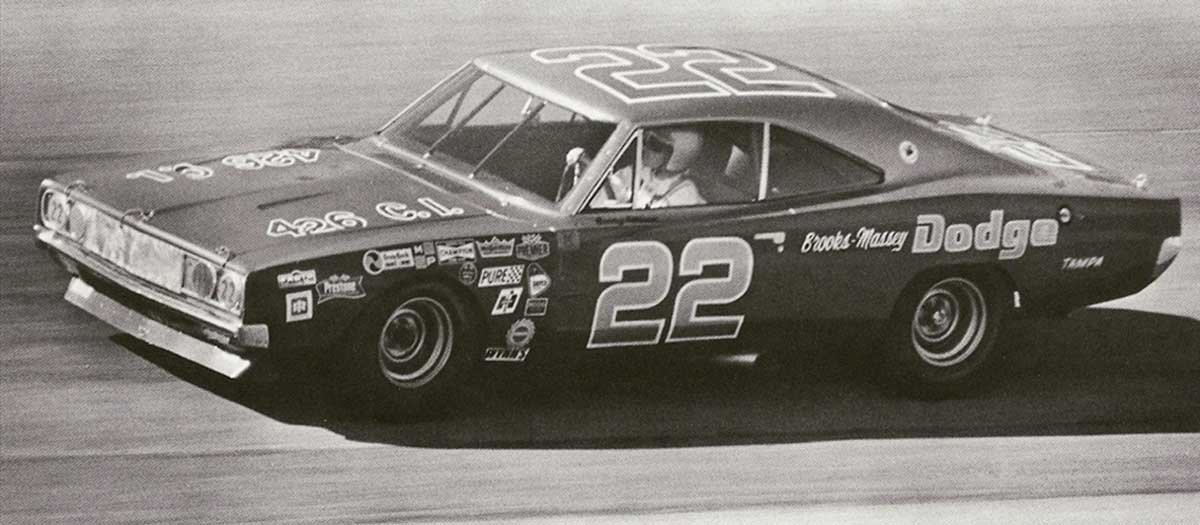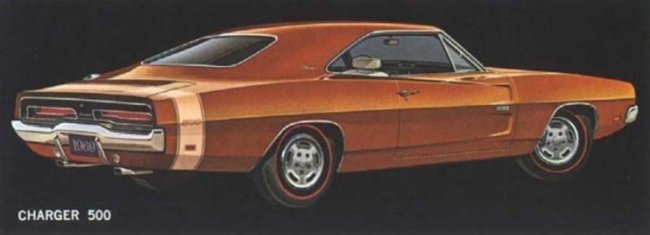
In the late 1960s, “win on Sunday, sell on Monday” was the mantra of the auto manufacturers. As a result, Dodge and Plymouth (Chrysler Corporation) and Ford and Mercury (FoMoCo) became involved in a one-upmanship battle to reign supreme at racetracks sanctioned by the National Association for Stock Car Auto Racing (NASCAR).
As the manufacturers realized engine development was resulting in less return on the money invested, the factory engineers had to develop other avenues of performance to keep their manufacturer in the winner’s circle. For example, rather than having raw horsepower pushing heavy, boxy vehicles through the air, the engineers began considering moving the air around the car more efficiently.

Above: The Charger 500 was added to the 1969 offerings from Dodge. It had a flush-mounted front grille and a back-window plug that helped reduce aerodynamic drag. The Charger 500 was Chrysler’s first response to the more aerodynamic Fords and Mercurys. Photo: Dodge sales pamphlet.
When Ford introduced the 1969 Torino Talladega, a more aerodynamic version of the track-proven Torino fastback, and Mercury launched the 1969 Cyclone Spoiler II, Dodge answered with the 1969 Charger 500. It came with a flush-mounted ’68 Coronet grille. Additionally, the flying-buttress roofline of the production Charger, which created massive drag as the air tumbled off the roof, was replaced with a rear window plug to smooth the air flowing over and around the Charger 500. The aerodynamic warfare, known as the “aero wars,” had begun.

Above: In the “win on Sunday, sell on Monday” era of NASCAR, the manufacturers pulled out all the stops. If more horsepower was too costly, it was time to figure out how to get the air to flow around the car more efficiently. Photo: Motorbase.com
Dodge continued its attack with an updated Charger 500 called the Daytona. The Daytona came with a radical aerodynamic nose cone and a high-mounted three-piece wing over the rear deck. Later, Plymouth got into the game with a modified Road Runner called the Superbird. It also received a similar aerodynamic nose and an even higher-mounted rear wing. The elevated wings on the Daytona and the Superbird led to the nickname the “winged warriors.”
A requirement of NASCAR was that each body style used on the track had at least five hundred production units offered to the public. At 392 units produced (did the NASCAR officials lose count?), the Charger 500 had the lowest production numbers of the three aero Mopars and, arguably, the fewest of all five of the aero cars. According to various data sources, Mercury produced 351 Spoiler IIs, although the Marti Reports state that 503 units were produced.
Above: The Charger 500s had some success in 1969. Of the 41 races it raced, it won nine, but the Fords and Mercurys won the rest. Photo: DodgeCharger.com
Chrysler commissioned Creative Industries to oversee the transformation of assembly line Charger R/Ts into Charger 500s. The 500 name was based on expected units to be built, not the widespread belief of the mileage distance of most NASCAR races.
The Charger 500 corrected the aerodynamic problems the 1968 Charger R/T had. Out of 49 Grand National races in 1968, the Charger R/T was victorious five times, Richard Petty won sixteen races in a Plymouth, and Ford and Mercury won the rest. In 1969, the Charger 500 ran in 41 Grand National races, winning nine. However, Ford and Mercury won the rest with their dropped snouts and aerodynamic fastbacks.

Above: Dodge called the Charger 500 – SLICK, and it was. The standard equipment included a 440, a Torqueflite or a 4-speed, dual exhaust, HD suspension and brakes, F70 x 14 tires, and a unique grille, backlight, stripe, and nameplates. An option was the 426 Hemi. Photo: Pinterest – Hot Rod Magazine
To meet the NASCAR required production numbers, a memo was sent to the Dodge dealerships on July 18, 1968, informing them about the 1969 Dodge Charger 500. The communication included information about the limited production numbers and that the Charger 500 would be equipped with only a 426 Hemi engine. Dodge quickly added the 440-wedge engine as an option.
Above: The Dream Giveaway Charger 500 is one of thirty-seven equipped with a 440, 4-speed, and an A33 Track Pack. The Charger 500 is the rarest of the Mopar aero cars, with only 392 built in 1969. Photo: Dream Giveaway
In addition, a 4-speed manual or a 3-speed Torqueflite automatic transmission was available. The Torqueflite-equipped Charger 500s came with a 3.23:1 geared 8 ¾-inch rear end, while the 4-speeds were outfitted with a Dana with stock 3.54:1 gears. The production numbers break down with fifty-two Charger 500s equipped with a Hemi, 340 with a 440 engine, and 106 had a 4-speed manual transmission.

Above: From the side, the Charger 500 looked like a Charger R/T except for the little 500 notation on the bumble bee stripe. The body shape looks like air would flow over it easily, but the Chrysler engineers had to add a flush-mounted grille and a rear window plug to help the air flow smoothly. Photo: Dream Giveaway
In the February 1969 publication of Hot Rod Magazine, author Steve Kelly evaluated a couple of Charger 500s, and his impressions were positive. Each car had power steering and power-assisted front disc brakes, both optional components. The power steering was an improved unit that retained road feel at high-speed, something the previous Mopar-assisted steering systems did not do effectively. The disc brakes were repeatable and consistent.
About the street version of the Charger 500, Kelly noted:
“You don’t have to wear a driving suit, crash helmet, or goggles in this Dodge a la NASCAR stocker – but if it makes you feel better, go ahead. The body shape is a real wind-cheater. The air traps have been designed out. Wait till a 500 gets on a super-speedway: half-a-foot lower and half-a-light year faster.”
Above: The Charger 500 interior is beautifully restored. Its appearance is the same (or better) than it was the day it rolled off the assembly line on September 27, 1968. Photo: Dream Giveaway
While not the big NASCAR success Chrysler had envisioned, the Charger 500 has established itself as a part of Mopar history. With the current selling prices of the Charger 500 well into the six-digit category, wouldn’t it be nice to get in a time machine, travel back to the fall of 1968, and pick up one of these rare NASCAR racers? Well, you can, sans the way-back machine. Dream Giveaway has a 440, 4-speed Charger 500 to be given away on April 11, 2023.
Above: The NASCAR-inspired Charger 500 was mildly successful, but it did act as a springboard for subsequent aero Mopar vehicles. The rarity of the street version of the Charger 500 has pushed its value well into the six-figure range. Photo: Dream Giveaway
The Concours-restored Charger 500 is an early build (9/27/68) once owned by NASCAR legend Ray Evernham. Furthermore, it is one of the thirty-seven documented examples equipped with a 440 and the A33 Track Pack option, including the A-833 4-speed, Hurst shifter, 9 ¾-inch Dana rear end with 3.54:1 gears, and Hemi semi-elliptical rear leaf springs. In addition, the Charger 500 features the correct R4 red exterior paint, a white interior, tachometer, console, AM radio with an 8-track player, power brakes, and 15-inch Magnum 500 wheels.
All that is necessary to have a chance to win the Charger 500 is a donation. For each gift, you will earn tickets. The greater the contribution, the more tickets. Each ticket is a possible winner, so get your tickets now and own a pivotal part of Mopar and NASCAR history.























 Mopar Connection Magazine – The ONLY Daily Mopar Magazine © 2022. All Rights Reserved. Mopar Connection Magazine is the ONLY daily Mopar Magazine bringing you the latest Mopar news, technology, breaking news, and Mopar related events and articles. Find out the latest information about Mopar, Mopar products and services, stay up to date on Mopar enthusiast news, dealership information and the latest Mopar social media buzz! Sign up for the Mopar Connection Magazine newsletter for the latest information about new products, services and industry chatter. Mopar Connection Magazine is the best and only source you need to be a Mopar industry insider!
Mopar Connection Magazine – The ONLY Daily Mopar Magazine © 2022. All Rights Reserved. Mopar Connection Magazine is the ONLY daily Mopar Magazine bringing you the latest Mopar news, technology, breaking news, and Mopar related events and articles. Find out the latest information about Mopar, Mopar products and services, stay up to date on Mopar enthusiast news, dealership information and the latest Mopar social media buzz! Sign up for the Mopar Connection Magazine newsletter for the latest information about new products, services and industry chatter. Mopar Connection Magazine is the best and only source you need to be a Mopar industry insider! by
by